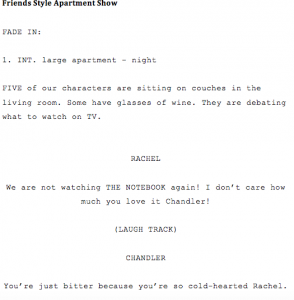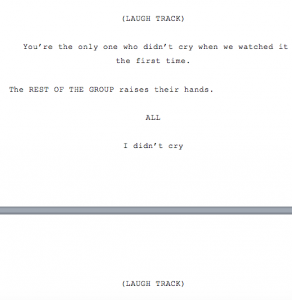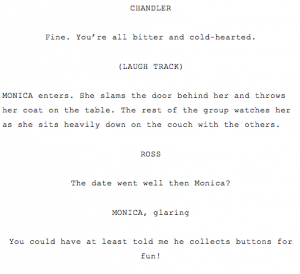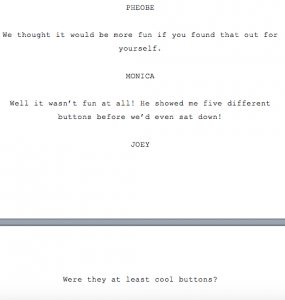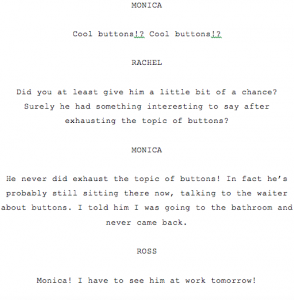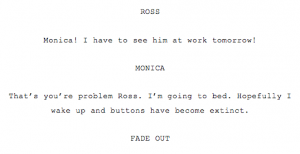Since deciding to work on the different formats comedic television can take, we’ve been watching, reading and exploring the formats we’ve chosen to focus on. I’ve been tasked with learning more about traditional multi-cam comedies. Given that I’ve seen all three shows in full, I looked specifically at Seinfeld, Cheers and Friends as examples of this format. After reading scripts from all three shows (see this post for more on that), I decided the best thing I could do to best understand the format would be to write a short script myself.
Friends, given its straightforward narrative, character tropes and comedic style, was the easiest show to write for. I know the characters well, having seen every episode multiple times. In a previous session with our group, we had decided that we should write scripts based around a simple storyline that could be adapted to suit each genre. I thought a bad dating experiencing would be easy to write, as well as being easy to adapt to our three genres; mutli-cam sitcom, mockumentary, and the stoner circle.
While I think that my attempt at ‘jokes’ are awful, I did try my best to make them fit with the style of Friends. While the situation is one that is ‘adult’ – drinking wine, going on a date, being in a large apartment owned by the characters – the jokes are very PG and accessible to a wide demographic.
I found it very easy to write for characters that have already been developed by someone else. The personalities were already there, and therefore it was easier for me to get down to writing a script rather than focusing on developing characters, locations and the basics of a show.
In relation to our final project, in this script I was able to explore how a multi-cam comedy is written. The characters to do not need to move around a lot, but still have the ability to do so if that’s how the director wants to shoot it.
In the first part of my script, I added in (laugh track) directions. While these are never written in actual scripts, I wanted to explore how my peers reacted to the directions – whether they could see where a joke was intended and where it wasn’t, and whether the cues made the jokes seem funnier. Speaking to my group after they read the scripts, it was clear the laugh cues were unimportant. It was obvious to them where a joke was intended, even if the joke wasn’t funny. The laugh cues also seem to imply that changes to the script at later stages would be hard to pull of. Having laugh track cues may put actors, other writes and producers off from improvising and improving the script, for fear of messing up an entire scene.
I found that this writing exercise was one of the most helpful things I have done during the early stages of this project. It allowed me to see where the script work and where it didn’t. It allowed me to explore writing in an easy format. My next step in this process is to story board this script and figure out the coverage, movement of the actors and camera angles.
